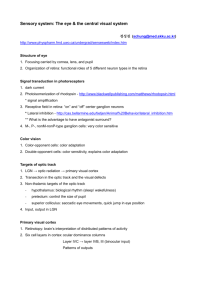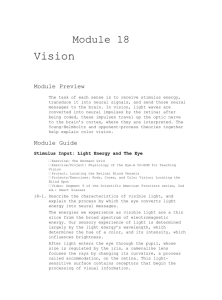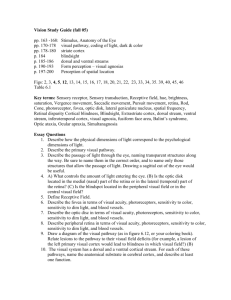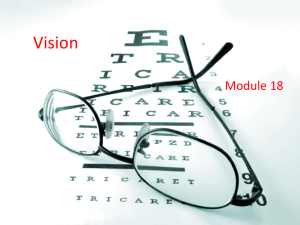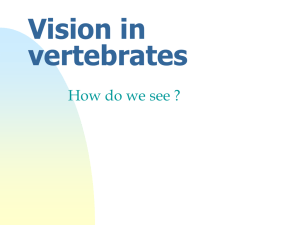The Visual Brain in Action: Chapter 1
advertisement
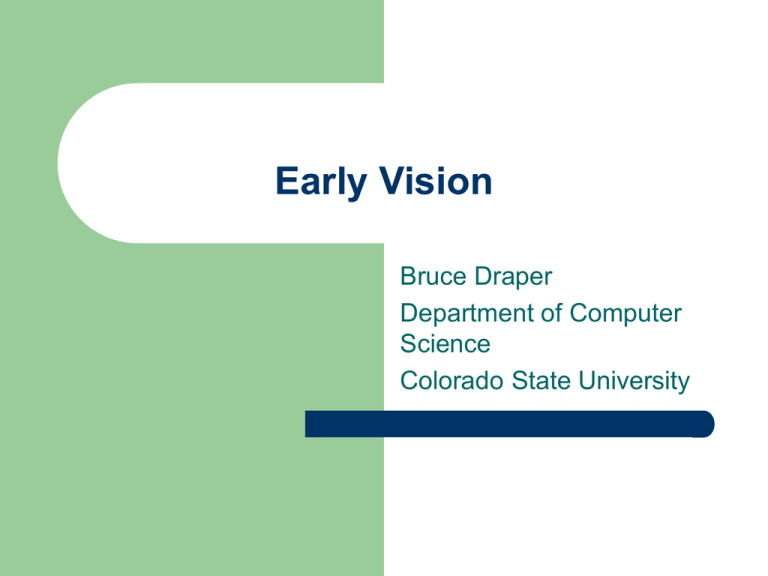
Early Vision Bruce Draper Department of Computer Science Colorado State University Overview “The Biomimetic Vision Trilogy” 1. Selective Attention – – 2. Early Vision – – 3. Understanding the problem Last week Understanding the literature Today Ventral vision – – Understanding object recognition March 9 (next week) General Theme Vision evolved to serve the needs of animals – Vision is action oriented (it guides behavior) – Actions may be immediate (e.g. grasp, navigate) Actions may be delayed (“perception”) Vision is not one system As animals became more complex, more and more visual capabilities evolved in separate systems Note: this is not a new idea. See The Visual Brain in Action by Milner & Goodale 1996; The Metaphorical Brain by Arbib 1972; or even Cybernetics by Weiner 1948. Input: The Eye(s) Start at the beginning: Lens focuses light Iris serves as aperture Retina contains receptors Optic nerve transmits to brain S. Palmer. Vision Science. P. 27 Lens, iris are controlled by muscles under the control of the brain Retina as Processor • Five cell types: • receptor (rod/cones) Species dependent • horizontal • bipolar cells • amacrine cells • ganglion cells • Its inside out! • Blind spot where optic nerve passes through retina S. Palmer. Vision Science. P. 30 Retina (cont.) Ganglion Cells – The first cells to produce spike discharges – – Other retinal cells use graded potentials Spikes are needed for long distance communication On-center off-surround Off-center on-surround Two Types of Ganglion Cells P ganglion cells in primates (like Y cells in cats): – – – – Large receptive fields (low frequency?) Transient response Fast transmission Receive inputs from all colors and from rods P ganglion cells (like X cells in cats): – – – – Small receptive fields (high frequency?) Sustained response Medium transmission Color opponent channels Fields of View & Stereo Right hemisphere receives the left visual field from both eyes – – And vice-versa Splitting the field of view supports disparity computations High resolution in fovea, lower elsewhere – Fovea is ±2° (thumbnail at arms length) Visual Projections The eye + optic nerve is a shared device There are eleven projections (“endpoints”) of the optic nerve: – Retinogeniculate Projection – Onto LGNd (Lateral Geniculate Nucleus, dorsal) and then to V1 (a.k.a. primary visual cortex, striate cortex)… This path is dominant in people; barely evident in nonmammals Retinotectal Projection Onto Superior Colliculus, then the Pulvinar Nucleus, then LGN, V1, MT, higher level centers… This path is dominant in non-mammals; evolutionarily older Involved in eye movements, motion, tracking Projections (LGN & S.C.) S. Palmer. Vision Science. P. 25. Projections (II) At least 8 more (minor) projections! – Retina Suprachiasmatic Nucleus – Retina Nucleus of the Optic Tract (NOT) – Optokinetic nystagmus Retina Accessory Optic Nuclei – Circadian rhythms SN is part of the hypothalamus (like LGNd) SN receives multi-modal projections Visual control of posture, locomotion Retina Pretectum Pupillary Light Reflex Two LGNd Channels P cells in the retina project to the two magnocellular (“large cell”) layers in the LGN. – P cells in the retina project to the four parvocellular (“small cell”) layers in the LGN. – Livingstone & Hubel: color-blind, fast, high contrast sensitivity, low spatial resolution L&H: color selective, slow, low contrast sensitivity, high spatial resolution LGNd also has interlaminar layers with unknown role/properties – Receives projections from optic nerve, S.C. Right at the levels of cells; wrong at the level of populations Primary Visual Cortex (V1) First cortical visual area – Columnar (like all cortex) Retinotopically mapped Ocular dominance columns Edges (Gabor filters), color, disparity & motion maps Connects to other retinotopic areas (V2, V3, MT) http://webvision.med.utah.edu/imageswv/capas-cortex.jpg Tootell, et al. 1982. Proof of Retinotopic Mapping Pattern flashed (like a strobe) in front of monkey injected with sugar dye Left primary visual cortex of the same monkey Single Cell Recordings in V1 Two Channels in V1 P Magnocellular LGN Layers layer 4C of V1. – Projects further to layer 4B Motion direction selective Orientation selectivity & binocular No color P Parvocellular LGN 4C of V1 – Projects to layers 2 & 3. Layers 2 & 3 subdivide into “blobs” and “interblobs”: – – – – – Blobs are color selective, simple receptive fields No orientation/movement direction selectivity, binocularity. Prefer low frequencies, have small Magnocellular input Interblobs have reduced (non-zero) color selectivity Binocular, high-frequency, orientation selective Jones & Palmer 1987 Simple Cells The first orientation selective cells found in V1 were labeled “simple cells” – Well approximated by Gabor functions with fixed orientations, scales and phases Complex Cells The second set of orientation selective cells were called complex cells – – Well modeled as combining 90° out-of-phase Gabor responses (quadrature pairs) Captures energy at a particular orientation & scale even filter + odd filter Organization of cells in V1 Hubel & Weisel proposed the following organization for cells in V1 Well, a little more complex… Ocular dominance columns Color-coded orientation Sensitivity columns More on V1 Only about 27% of V1 cells are orientation selective About 70% of orientation selective cells are complex cells Orientation selective cells also include end-stopped cells (a.k.a. hypercomplex cells), and grating cells. Non-orientation selective cells include cells that respond to: – – – Color (Hue/Sat maps?) Disparity Motion V1 Connections V1 is the starting point of cortical visual processing. Dorsal projections lead to somatosensory and motor control areas Ventral projections lead toward associative memories From Van Essen 1992. Image can be found at http://webvision.med.utah.edu/imageswv/Visual-Cortex1.jpg Anatomical Maps of Visual Cortex 1983 Version 1990 Version Two Visual Subsystems In 1982, Ungeleider & Mishkin propose that there are two primary visual pathways in humans and primates: – The dorsal (or “what”) pathway – Ends in the posterior parietal cortex The ventral (or “where”) pathway Ends in the inferotemporal cortex Visualizing Two Subsystems D. Milner & M. Goodale, The Visual Brain in Action, p. 22
